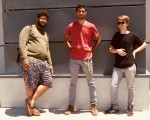Bruce Lee’s martial arts philosophy influences Kune Do, a band which incorporates a multitude of different styles of music.
The band was first created by Atticus Reynolds and fourth-year cognitive science student Ram Eshwar Kaundinya when they realized the similarities between traditional Indian rhythms and Puerto Rican rhythms. Though the band, ranging between three to four members, does play composed songs, much of its focus is on improvisation. Kaundinya said the spontaneity allows them to incorporate many styles such as Afro-Cuban and electronic. The band will be performing their combined music styles at the school year’s first “Fowler Out Loud” event Oct. 17 featuring a series of student concerts.
“The biggest thing is listening and having an open heart for people you’re playing with. It is something that is natural and you can’t do it if you’re trying,” Kaundinya said. “One of the big things is not to step on each other’s toes.”
The band’s name was inspired by Bruce Lee’s martial arts style Jeet Kune Do, which means “the way of the intercepting fist.” Kaundinya said this serves as the band’s philosophy – though they may tend to focus on specific music styles, there is no one way of playing their music, focusing on the idea of “the way.” Kaundinya himself often incorporates traditional Indian tabla drums or Cuban congas.
When improvising a song, Kaundinya said the band members play off each other. If a song is driven by meter and rhythm, he said they might include congas, which emphasizes the beat, or a tumba drum that would fill in the gaps between the meter. Improvisation also impacts other instruments as well. For example, if the saxophonist is playing a punchy tune, Kaundinya said he would likely let that shine.
Improvisation does not have hard rules, Kaundinya said, and instead the musicians focus on what they feel in the moment. Theo Lee, who will be playing the analog synth and an electric piano, said that though they do make mistakes when improvising, much of the fun of such creation comes from working through the mistakes.
“Improvising is interesting because it’s a lot of risk-taking and a lot of quick decision making. In the end, you have to just trust your gut and you have to do it like breathing,” Lee said. “You can’t think about it, you just have to do it.”
Historical inspiration is also incorporated through audio clips often interspersed throughout their music. Much of their electronic influences come from recordings giving tribute to their musical inspirations, Kaundinya said. They often begin with a sound clip and then base their musical improvisations around it, such as clips of musician Herbie Hancock talking about his music, Kaundinya said.
The group’s small size aids in creating a cohesive sound, Reynolds said. With only three main members and the occasional harmonic, it’s easier to focus on creating sounds that work with each other, as opposed to cluttering the composition with many instruments, Reynolds said. Though they may be incorporating a multitude of styles and ideas, Kaundinya said focusing on personal musical influences allows their music to flow more naturally.
“To describe it, it sounds like a blob of so many different things. I think what draws it together is the fact that we connect deeply to each inspiration we bring to it,” Kaundinya said. “We strive to present it with that full authority and context.”
